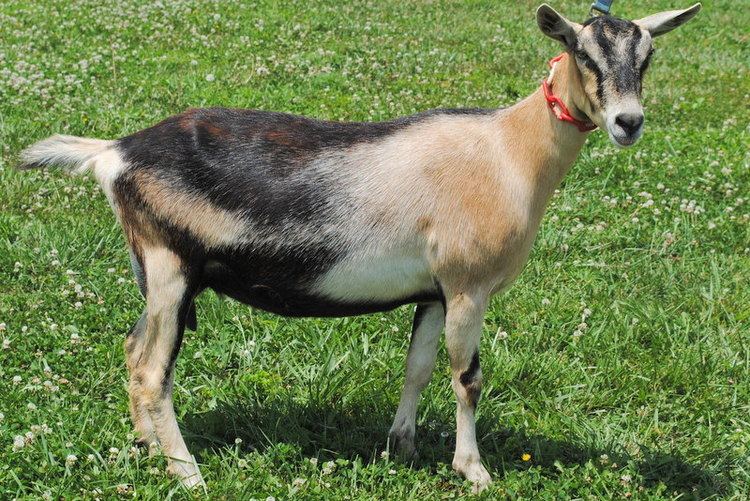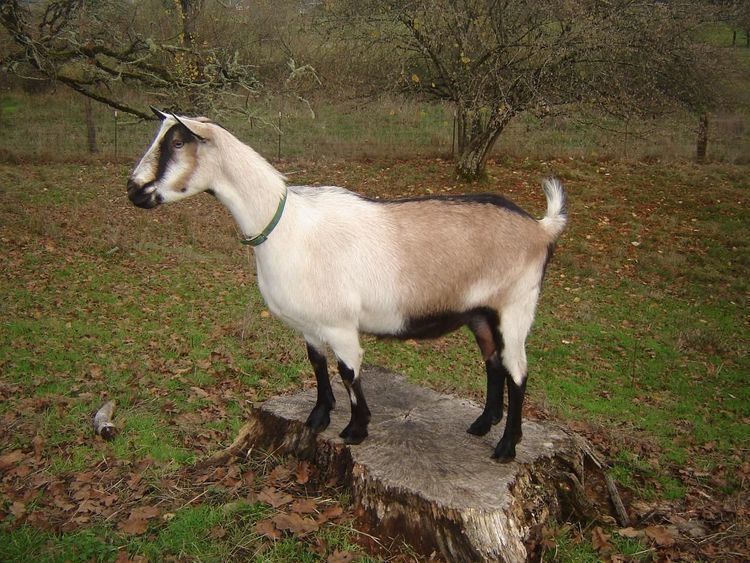Conservation status Least Concern Use Dairy, crossbreeding Higher classification Goat | Country of origin France Scientific name Capra aegagrus hircus Rank Breed | |
 | ||
Other names Alpine polychrome, American Alpine, French Alpine Weight Male: no less than 77kg (170lbs)Female: no less than 61kg (135lbs) Height Male: no less than 81cm (32in)Female: no less than 76cm (30in) Similar | ||
The Alpine is a medium to large sized breed of domestic goat known for its very good milking ability. They have no set colours or markings (although certain markings are discriminated against). They have horns, a straight profile and erect ears.
Contents

The breed originated in the French Alps. Mature does weigh around 61 kg (135 lbs), and are about 76 cm (30 in) tall at the shoulder. Alpine goats can range from white or gray to brown and black. Alpine goats are heavy milkers. The milk can be made into butter, cheese, soap, ice cream or any other dairy product normally made from cow's milk . They are often used for commercial dairy production, as well as homestead milk goats.

The French Alpine is also referred to as the Alpine dairy goat and registration papers for this dairy goat use both designations as they are synonymous. These are hardy, adaptable animals that thrive in any climate while maintaining good health and excellent production. The face is straight with a straight nose as most other European breeds of goats. Toggenburg color and markings, or all-white is discriminated against.

Alpine goats near les houches france
Types
Several sub-types of Alpine goats have emerged, namely:
Characteristics
Alpine goats are a medium to large sized breed. Males are over 81 cm (32 in) tall at the withers and females are over 76 cm (30 in) tall at the withers. Their hair is short to medium in length, and they come in all colours and combinations of colours. They have erect ears and a straight profile, and are described as being "alertly graceful" with the ability to adapt to any climate thanks to their hardy nature. They are the only breed with erect ears that comes in all colours and combinations of colours.
The sexual maturation rate among Alpine goats is at four to five months after birth for buck kids, and five to six months after birth for doe kids. However, doe kids should not be bred until they are at least 75-80 lbs. A does gestation lasts for 145 – 155 days, with 150 being the average. Twins are the most common, but they can have singles, all the way up to quintuplets .
Alpine goats are friendly and highly curious, however they can be independent and strong-willed.
Color Patterns
Traditional Alpine colors are described using the following terms:
Any variation in the above patterns broken with white should be described as a broken pattern such as a broken cou blanc.
The American Dairy Goat Association faults all-white and Toggenburg patterned individuals.
History
Alpines goats originated in the French Alps, and are descended from the Pashang goat, also known as the Bezoar goat.
USA
Alpine goats were first brought to North America in 1922 by Dr Charles P. Delangle, who imported 19 does and 3 bucks. They were shipped from Paris to New Orleans (quarantined in Cuba along the way), and transported overland by rail to California, where Delangle kept his herd, "Alpine Goat Dairy". However, on August 20, 1923 he was expelled from the American Milk Goat Record Association and soon after sold his herd. All modern goats registered as purebred Alpines in the United States are directly descended from these 22 animals.
Over time, crossbreeding of French Alpines with various breeds of goat produced the American Alpine, a sub-type of Alpine dairy goat. This sub-type is generally a larger, stronger and more productive animal than the purebred type.
Milk
Known for its milk, the Alpine goat is famous for its rich dairy production. Alpine goats are extremely popular in the dairy industry for their docile temperament, high quality milk output and long lactation. Alpine milk has relatively low fat content, with an average fat percent of 3.4%. It is higher in sugars than cows' milk but balances itself in terms of the amount of protein. Alpine Goats' milk has 2.3g of protein per 250ml while Cow’s milk has 3.4. A higher protein count is not always good, since it packs more calories with an increased fat content. Compared to Saanen Goat Milk, it is higher in all nutritional aspects, except the fat content, making it a much healthier choice.
Alpine goats are one of the top milk producers, alongside Saanen and Toggenburg goats. They are distinct from the other two due to their low value of fat content. This could be a direct correlation between the weight of the animal and its habitual environment. Unlike the Nubian goat, whose weight is similar to that of the Alpines at maturity, yet produces a lower milk value with an increased fat content.
The peak periods for milk production occur after four to six weeks of puberty. The optimal weight at which a goat produces optimal milk production is at least 130 pounds. For the Alpine goat that number is higher at 135 pounds and produces 2,134 pounds of milk per lactation. Good nutrition, proper milking procedures, reproductive management, and disease control are also factors that contribute to milk production of the Alpine Goat.
There are four requirements that need to be efficient for optimal dairy production. Dairy goats must be housed in specific conditions so that their milk production is not alarmed by changes. Changes in external factors can cause a decrease in milk production due to the pressure applied on the goat to adapt to these changes. The four factors for optimal production are; adequate ventilation, dry beds, uncontaminated feeder and water supply, minimal labor and disturbance.
Alpine milk, as with all goat milk, must be filtered and chilled immediately upon separation from the lactating doe when intended for human consumption. The temperature at which milk will remain the best is at 4.4 degrees Celsius. Cooling is required immediately of the milk so that there is no excess bacteria growth. Warm bacteria grows at a faster rate and multiplies so that the milk is spoiled. The milk that is refrigerated has a shelf life of about three to four weeks. However, consumers like to freeze the milk and increase its shelf life by about four to five weeks.
